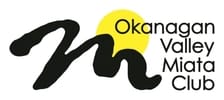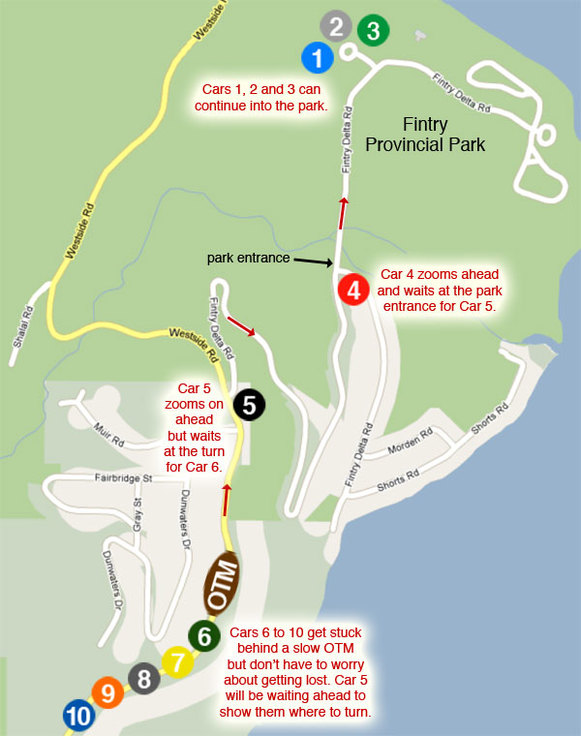notes for participants
part a: bread crumbing - the golden rule
When driving in a club event, most of the time the event leader can’t see all the cars in the group, which makes it difficult for the leader to know if the group has been separated or if any members of the group have made a wrong turn. We use CB communication at the front and rear of the group of cars in order to relay information but CB reception can be spotty, especially with larger groups in rugged terrain.
Fortunately there is a nearly foolproof strategy that can be employed during club drives. If every participant takes on a very small amount of responsibility much of the pressure can be taken off the leader, and the group as a whole can have a fun drive without anyone getting lost.
When driving in a group we seem to instinctively focus on following the car in front, thinking we need to keep in visual contact to avoid getting lost. But in fact, the single most important factor as a participant is to pay attention to the car behind you and follow the golden rule: NEVER TURN OFF THE ROAD YOU ARE CURRENTLY ON UNLESS YOU HAVE VISUAL CONTACT WITH THE CAR BEHIND. If every car in the group adheres to that one simple rule, nobody can ever get lost. This strategy is referred to as "breadcrumbing".
Any place where using a turn signal is required automatically qualifies as as a place where you must have visual contact with the car behind. In addition, visual contact is also required at any Y, fork in the road, or any other part of the route where a choice of direction may not be obvious. Here is an example of breadcrumbing which is illustrated by the map below.
Fortunately there is a nearly foolproof strategy that can be employed during club drives. If every participant takes on a very small amount of responsibility much of the pressure can be taken off the leader, and the group as a whole can have a fun drive without anyone getting lost.
When driving in a group we seem to instinctively focus on following the car in front, thinking we need to keep in visual contact to avoid getting lost. But in fact, the single most important factor as a participant is to pay attention to the car behind you and follow the golden rule: NEVER TURN OFF THE ROAD YOU ARE CURRENTLY ON UNLESS YOU HAVE VISUAL CONTACT WITH THE CAR BEHIND. If every car in the group adheres to that one simple rule, nobody can ever get lost. This strategy is referred to as "breadcrumbing".
Any place where using a turn signal is required automatically qualifies as as a place where you must have visual contact with the car behind. In addition, visual contact is also required at any Y, fork in the road, or any other part of the route where a choice of direction may not be obvious. Here is an example of breadcrumbing which is illustrated by the map below.
|
A group of 10 cars are driving along Westside Road from Kelowna to Fintry Park. The last 5 cars are held up behind a slow OTM (other than Miata) on Westside Road. The first 5 cars are free to continue zooming at their regular fun pace and leave the others behind.
When the first group arrives at the turn, Fintry Delta Road, cars 1, 2, 3 and 4 can make the turn and continue on, but the last car in the first group, car 5, is responsible for pulling over just prior to the turn onto Fintry Delta Road to make sure car 6 sees where he is turning. Having continued on, cars 1, 2, 3 and 4 arrive at the park entrance. Cars 1, 2 and 3 are free to turn into the park and continue on, but car 4 can no longer see car 5 behind him, so car 4 is now responsible for waiting at the Fintry Park entrance until car 5 arrives. When car 6 catches up to car 5, car 5 turns down Fintry Delta Road with the rest of the group in tow. When car 5 catches up to car 4, car 4 turns into the park entrance with the rest of the group in tow. The breadcrumbing method not only prevents people from getting lost, but it is also much safer. Breadcrumbing makes it necessary for only one car to pull over and wait in any given spot, whereas finding a safe place for a large group to pull over and wait for someone on narrow country roads can be difficult and dangerous. It should be noted however that although it is only necessary for one car to pull over and wait at each turn with this method, there is nothing wrong with several cars pulling over together to wait for the others as long as there is enough room to do it safely. |
Another benefit of breadcrumbing is that it allows people to travel at their own pace. It is not necessary to drive at a speed you are not comfortable with in order to keep up with a car that wants to zoom off ahead. That car will be waiting for you at the next turn.
Breadcrumbing is fairly easy in rural areas where most back roads have shoulders to pull off on and where traffic is usually lighter. Finding a safe place to pull over and not impede other traffic is not usually a problem. It can however get tricky through cities where there may not be a safe place to pull over. If you can't see the car behind and you are not able to safely pull over prior to a turn, try to give the car behind the best possible shot at seeing you by slowing down to delay making the turn for as long as possible, then make the turn and pull over as soon as there is a safe place to do so. If there is still no safe place to stop, drive as slowly as you can without impeding regular traffic
Breadcrumbing is fairly easy in rural areas where most back roads have shoulders to pull off on and where traffic is usually lighter. Finding a safe place to pull over and not impede other traffic is not usually a problem. It can however get tricky through cities where there may not be a safe place to pull over. If you can't see the car behind and you are not able to safely pull over prior to a turn, try to give the car behind the best possible shot at seeing you by slowing down to delay making the turn for as long as possible, then make the turn and pull over as soon as there is a safe place to do so. If there is still no safe place to stop, drive as slowly as you can without impeding regular traffic
part b: to pass or not to pass
Many of the roads we travel are narrow, winding country roads so passing among the group is not encouraged. It is acceptable if it is done in a safe and legal way, and it is best to restrict passing to highways and open roads. To avoid the need to pass in the first place, the best practice is for the more “ambitious” members to position themselves near the front from the start, and those who prefer to travel more slowly position themselves near the back of the group.
part c: communication
Participants can help make events run more smoothly by using a GMRS radio. Being able to hear instructions from the leader is obviously very valuable and would virtually eliminate the possibility of getting lost. In groups of about 20 cars or more the distance and terrain may cause poor radio reception between cars at the front and cars at the back. However, in larger groups members can be advised to relay messages through the line to insure that everyone is informed.
GMRS radios can typically be had in pairs for less than $100, and most come with rechargeable batteries. There is no need to mount anything on your Miata. If you have equipment or installation questions, feel free to approach any of our members with a GMRS radio. They will be happy to show you what equipment they have and how to operate one properly.
It may also be helpful for participants to exchange cell phone numbers prior to the run as added security in case someone gets lost. It may be an especially good idea for those without radios
GMRS radios can typically be had in pairs for less than $100, and most come with rechargeable batteries. There is no need to mount anything on your Miata. If you have equipment or installation questions, feel free to approach any of our members with a GMRS radio. They will be happy to show you what equipment they have and how to operate one properly.
It may also be helpful for participants to exchange cell phone numbers prior to the run as added security in case someone gets lost. It may be an especially good idea for those without radios


